While we wait for the announcement of Site J’s new name (expected later today), the NAVCAM mosaic presented in this blog post shows the landing site as Rosetta left its 10 km orbit last week in order to prepare for the deployment of Philae on 12 November.
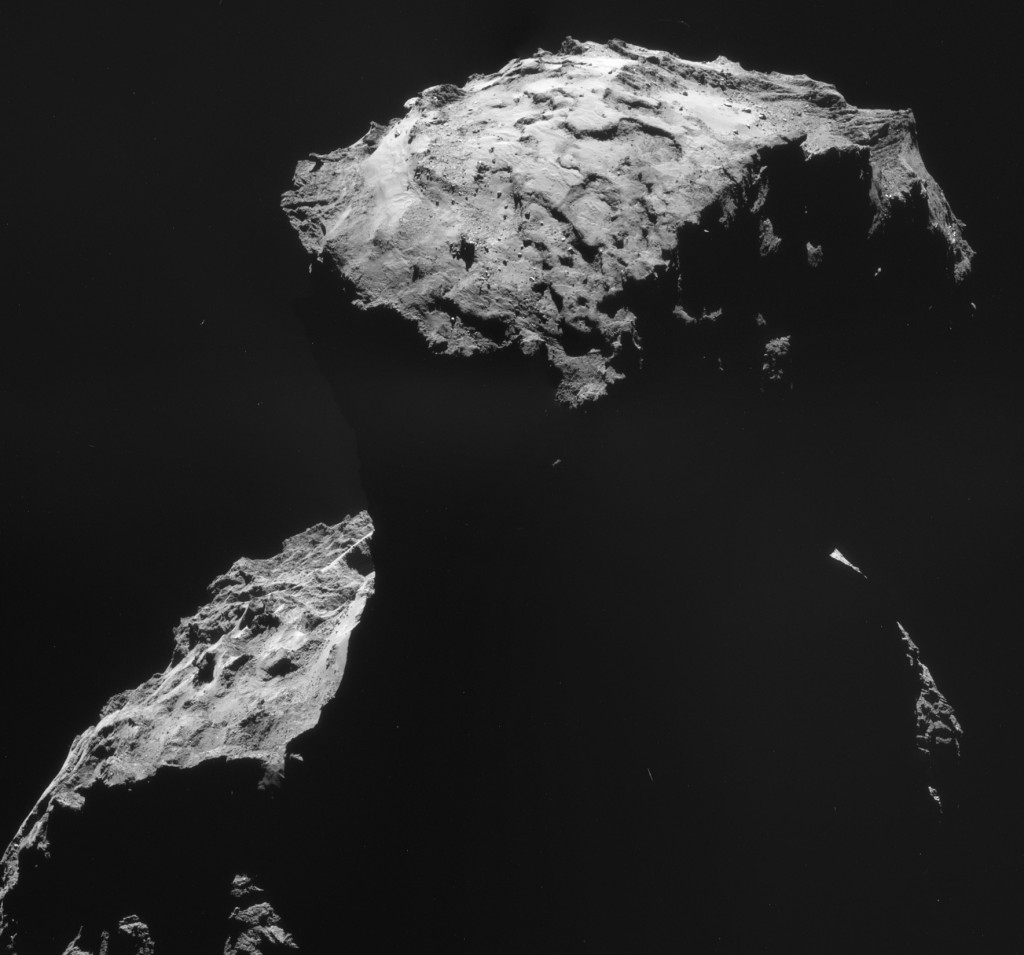
Four-image mosaic of Comet 67P/C-G on 30 October. Credits: ESA/Rosetta/NAVCAM – CC BY-SA IGO 3.0
The mosaic comprises four individual NAVCAM images taken on 30 October when the spacecraft was 26.8 km from the centre of the comet. The image resolution at this distance is 2.27 m/pixel, and thus each 1024 x 1024 frame covers 2.3 km at the comet. The slightly cropped mosaic covers 4.0 x 3.7 km.
Even at this increased distance from the nucleus, the time between the four NAVCAM images means that it is difficult to make a completely accurate mosaic. Thus, as always, caution is needed in interpreting some features on the surface and faint emission around the nucleus. As usual, the four individual images are also provided.
The centre of the landing site is located roughly in the top centre, close to the horizon in this viewing angle; check against this image to help with orientation. The large depression that characterises the smaller lobe of the comet can be seen in the right-hand side at top right, while parts of the larger lobe can be seen in the lower half, with the still unseen portion of the comet again cast in dramatic shadow.
Note that with this post, we are now releasing all NAVCAM images under a Creative Commons licence (see the credit line), as explained in more detail in an accompanying blog post.

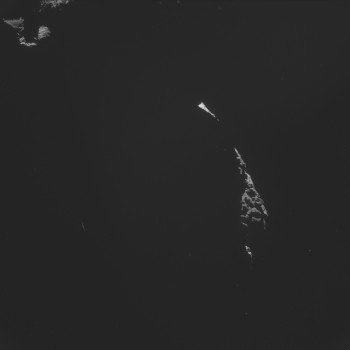
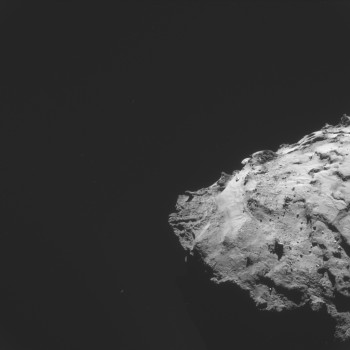
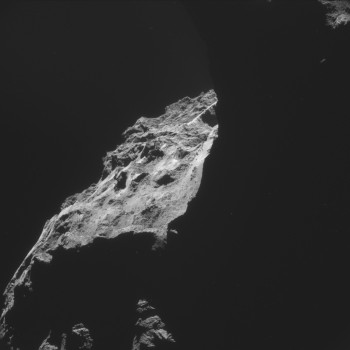
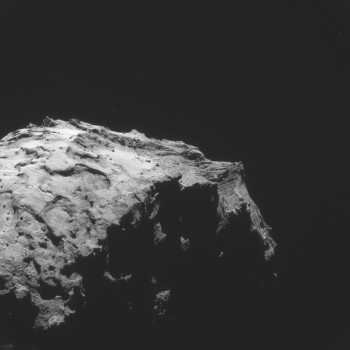








Discussion: 32 comments
Thats one hell of a dark shot.. looks like fresh out of a Horror Sci-Fi movie. Esp. with the Arival scheduled so close 🙂 One shot before Oblivion…
“Who knows where it’s been, what it’s seen. Or what it’s brought back with it”
The 26th October pic of site J looks like a duck, with rocks in the shape of eyes and a bill, and this enchanting silhouette from the 30th October reminds us of the size of the challenge ahead x
Got that. 🙂 Happy to see someone else searching for geometries.
An enhanced version of the 4-image mosaic showing dust and small free-floating chunks of debris:
https://i.imgur.com/9jZFupA.jpg
The image has been obtained from the 4-image mosaic by averaging the original version with a brightness stretched version, then adding a hipass (rad 20) version of the intermediate result.
Image source: ESA/Rosetta/NAVCAM, CC BY-SA IGO 3.0
https://creativecommons.org/licenses/by-sa/3.0/igo/
modified by “Gerald”
Movie quality 🙂
Planar collimation.
Think this image is important. Please create redundancy on Gerald work.
Thanks, too much of honor! My work is less than 0.1% of the effort which has been necessary to obtain the image. The other more than 99.9% of credit go to the Rosetta teams, and many people in the background, who made this and other great missions possible.
60º between planes?
Have you actually brought up to the front the ‘noise’ bits? 🙂
How many of the debris particles of the enhanced version on imgur are simply detector noise?
I don’t think, that many of the particles are detector noise. Lot of dust has also been obvious in OSIRIS images; there it has been possible to even track some particles from one image to the next one.
At the left side of the comet, the foreground is darker than the dusty coma in the backgroud, indicating lot of activity, including ejection of dust.
Maybe I am guilty about the confusion. Noise by definition does not follow ANY pattern. [should say] Does the applied filter remarks the the higher frequency waves?
A new very good NAVCAM mosaic !
But WHY you NEVER post OSIRIS pictures of J, whose
resolution should be strongly better, clearly explaining
the choise of J ?
In this situation, suspect increases of some OSIRIS malfuncton.
Well, this has been addressed before… “All Rosetta science instrument data have a proprietary period of 6 months, after which they will be publicly available…” (ESA policy). It is not a problem of malfunction, it’s an academic decision among scientists… So you have to be patient. Before that, the OSIRIS team should nevertheless accept that “some” images are to be shown to the world of taxpayers.
https://blogs.esa.int/rosetta/2014/07/16/access-to-rosetta-data/
OK for the ESA policy.
But people don’t ask for ALL OSIRIS pictures but only for
SOME RECENT Osiris picture of the so strategic J site. It is true that ESA promised to release ALL OSIRIS pictures after six months but at that time these pictures will have lossed their real interest. In other word, six months or more is exately the same !
Well Gerald, The hills are alive with the ………
Hello Emily !
One Question :
During the livestream of Philea-landing, do you speak as a ” moderator of emotion “with the fans of rosetta ?
Live on ESA-stream ?
That would be graet !
I thought images from further out than 10Km would be a bit “after the Lord Mayors show’, but no, 67P still has a flair for the dramatic. One of the best views we have had of Landing Site I. No wonder the team didn’t want to land there, its plastered in rubble and virtually no room to bail out. That is something “Agilkia” has got going for it, even if Phylae misses the target there are flattish areas she can still land on. Those big bouldery cliffs in front of Cleopatra and the centre of the landing ellipse look a lot worse in this image than in others we have seen. Are those two boulders in the circular plain beyond Cleopatra giving off a large plume of gas and dust right between the two peaks on the horizon?
Fascinating image from Gerald. Areas not covered in the dusty Laktrtz layer, are so much brighter and clearly picked out in this image. All around the edges of the lobes and on exposed promontories and protrusions. Yet the neck plain at the base of the Amphitheatre, which we know is covered in the dusty Laktrtz layer, is even brighter.
@Robin “Yet the neck plain at the base of the Amphitheatre, which we know is covered in the dusty Laktrtz layer, is even brighter.”
Sorry to butt in again, but:
1) The German word “Laktritz” is spelt with an “i” in the second syllable.
2) I don’t see why you prefer the German word to the plain English term “liquorice”, which those who don’t speak German can understand as being something black but, above all, totally sticky.
3) If we have to resort to a foreign word, I’d actually prefer the French word “réglisse”: if only because its second syllable is “lisse”, meaning “smooth” in English, and its first syllable is pronounced rather like “règle”, meaning “rule”. The black, smooth properties of all those boulder-strewn plains on 67P/C-G indeed seem to be the rule…
Leaving trivial linguistic considerations aside though, what allows you to assert that “WE know” that the “liquorice” is “covered in” a “dusty […] layer”? Personally, I know nothing of the sort. The presence of a layer of dust covering those “liquorice” plains remains, for the moment, as much a matter of pure speculation as is the reputedly “sticky” nature of the underlying surface which you suggest. I repeat that for the moment “we” know absolutely NOTHING about the precise nature of those smoother areas. (Presumably the mission scientists know rather more than “we” do, but nothing has leaked out yet, as far as I know). For the time being, we are simply entitled to speculate and make predictions.
My personal bet from an EU perspective, (since we’re getting into money time…), is that those smooth plains are made of something much more akin to lava. i.e., that they are rock hard since the layer of molten rock produced by the extreme heat of generalized electric discharge phenomena quickly solidifies once the current focus has passed on, to form the vitrified surfaces we see (perhaps covered in, at most, a few millimetres or centimetres of silicate “dust”, depending on local electrostatic conditions). I therefore believe that Philae (if ever it manages to land safely) has absolutely no chance of acquiring any sort of foothold on the surface of the comet via the harpoons and ice-screws it was equipped with at a time, over ten years ago, when it was still just possible to believe that comet nuclei were mainly formed of ice.
I would thus personally consider the EU model of comets to be falsified if ever Philae succeeded in landing safely, with all systems working, and managed to anchor itself, as planned, to a layer of ice (or of liquorice…).
Is anyone prepared to state what sort of outcome could possibly falsify the standard theory?
Hi THOMAS. Are you putting the live of a model in the flip of a coin? Should I say the flip of a Philae?
“All and all… fully working”. Not even my Honda. What kind of bet is this? Is science a ‘betting’ thing? I have not abandoned Galileo models yet. They’re useful.
Always enjoy your flippant comments, Logan!
Hi Thomas. You know you are going to set me off on another verbal ramble, I should thank you for the inspiration. My spellchecker doesn’t speak German unfortunately. The word “Laktritz” was first appropriated by Cometstalker to match what he thought the large plains were covered in. I was getting fed up with using a long winded description such as, “the surface layer ESA tells us is porous, contains some organics that resemble those found in Tar, that contains very little or no ice and gives the appearance of a mineral dust with a very fine grain and in colour and texture is similar to printer toner”. A simple word to cover all that seemed more sensible. Personally I don’t think it resembles liquorice at all, other than it is black. Your suggestion of “réglisse” seems far more appropriate, if we anglicise it to “reglisse”, so it is part regolith, part the French for smooth , it would fit the bill nicely don’t you think? Includes both the primary languages of ESA too.
It appears some confusion has taken place as to what I mean by the Laktritz layer. I have taken it to be a term meaning the top layer we see covering all the large flat plains, the neck plains and much of the formations that look like rock. We have evidence, admittedly a minuscule sample, that mineral dust has been found in the coma and ESA tell us it has come from the comet’s surface. No doubt some might say, “it could have been machined off the rocks on the surface”, by the, as yet, unseen and unmeasured electrical discharges battering the comet and producing all the ejecta we see. If we are to believe ESA then we know there is mineral dust on the comet and they have also said the surface layer is analogous to printer toner. Further more there is visual evidence, which I am sure you accept unreservedly, of the surface “Reglisse” exhibiting the behaviour of a dust or powder like material, such as small dust slides at the edges of cliffs.
The question I raised was, the surface layer covering the volcanic plains appears to look the same as the surface layer of the neck plains, the swirly patterns, smooth appearance, very similar shade of grey, even when compared in the same image, one therefore might reasonably think they are the same material. That did not appear to be the case in the image Gerald produced, they appear different. Surely Thomas you are not suggesting that just because they look the same in one image that doesn’t mean they are necessarily the same material. No I can’t believe that, surely just a verbal joust.
I am worried though, that you are prepared to give up EU theory on an at best, ambivalent outcome. If there is a layer of rock dust, say 2 metres deep which has accumulated over the millennia, compacted to a certain extent by processes unknown, Philae could quite successfully attach herself to the comet, yet below this surface layer could still be rock or ice.
Perhaps it might be better to consider the amount and density of matter required to provide the number of electrons sufficient to manifest themselves as the currents involved in rock melting and planet gouging electrical discharges. 1 ampere requires 6.241 x 10^18 electrons. Interplanetary space is not a pure vacuum, but I am struggling to find the amounts of matter to provide the electrons for one amp of current let alone those sorts of currents. The density of matter in interplanetary space is 10 to 20 molecules per cubic metre depending on the source.
Granted the density of matter in the coma of a comet is higher, but at some point it wasn’t and the mechanism proposed for getting it there not possible. On Earth lightening is the most powerful natural electric discharge, it has molecules in the atmosphere with a density of around 1.2 Kg/m^3 to provide electrons. Lightening on Earth does not melt rocks or gouge huge craters, tiny pits and scars are the best it can manage. Increase the density of the atmosphere, like on Jupiter and Saturn, we see mega lightening, with huge currents and voltages. The puny atmosphere of a comet’s coma is not going to be able to propagate any sort of destructive electrical discharge.
I am not sure whether you mean the standard “dirty snowball” model or the standard model of the Universe. Since we are discussing the Electric Universe model I assume the second. If 67P were found to be made entirely of rock and therefore should have a mass 6 times what gravitational calculations have predicted, but still the process of reaching and orbiting 67P has been accomplished, I’m sure that would cause some consternation. Some repeatable and verified measurements that show Relativity is wrong might work, or some amazing new theory of everything that gives the answer 42.
I’m not aware of anything that determines that there has to be some unified theory of everything, our own hubris perhaps. Our experience of the Universe is that it doesn’t limit itself to one of anything. General Relativity and Quantum Mechanics could be just two of four, six or n different independent models needed to describe the entire Cosmos.
‘Sprites’ occur at lower densities and at least a scientific source claims gamma ray emission. What could gamma ray do?
Who says that ‘machining’ has to be at proton-ed surface?
How much danger is posed to Rosetta and Philae by these small free-floating bits of material?
Hi Andy. At least to optical instrumentation.
This is an enhanced Navcam Montage of the Polar Dust Jets with very high phase angle with sunlight forward scattered through the dust jet. The jets are presumably being viewed broadside to the fan of dust jets. The fourth “D” image of the mosaic series was not used due to high camera flare.
Image Source: ESA/Rosetta/NAVCAM CC: BY-SA IGO 3.0
https://creativecommons.org/licenses/by-sa/3.0/igo/
https://univ.smugmug.com/Rosetta-Philae-Mission/Rosetta-Dust-Jets/i-xwqTLjB/0/L/ESA_Rosetta_NAVCAM_141030_A-B-C–montage–enh-L.png
–Bill
Hi Bill,
nice picture again, still not possible to decide, sublimation from below the surface through vents or porous rock or electric discharge of the surface directly.
Although the collimated dust look like its driven by the electrical effects as the currents would generate their own magnet field to lift and accelerate the dust & particals
Is it possibe to share this picture of OSIRIS / Lutetia
https://www.dlr.de/dlr/Portaldata/1/Resources/bilder/missionen/rosetta/16_9/ros_lutetia.jpg
under the license “Image Source: ESA/Rosetta/OSIRISCC: BY-SA IGO 3.0” ?
My take on this mosaic:
https://www.flickr.com/photos/105035663@N07/15715801426/in/photostream/